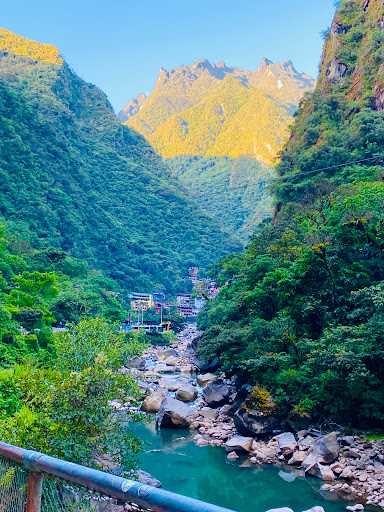App
Customer Support
Find Bookings
Cusco: The capital of the Inca Empire, a city where Inca and Spanish colonial architecture coexist. Moray is one of them. A unique Inca ruins located in the Sacred Valley region near Cusco, Peru. It consists of huge circular terraces and is widely known as the agricultural experiment site of the Inca civilization. Sacred Valley (Urubamba Valley): The center of Inca agriculture and religious ceremonies, various ruins and traditional villages remain. The most mysterious place is the salt pans here. Salinenas!! A unique terraced salt pan located in a mountain valley at an altitude of about 3,300m. This area was originally a sea area long ago, and when the area was uplifted, salty water rose from underground, and the Incas used it to create about 3,000 small terraced ponds to produce salt. #Peru #Salinenas Terracing is a traditional agricultural technique that is very effective in soil protection and erosion prevention by cutting sloping hillsides into terraced farmland. Soil erosion preventionTerracing significantly reduces soil erosion by preventing rainwater from quickly flowing down the slope. Each terrace temporarily holds rainwater, increasing infiltration time and minimizing soil loss. Water and nutrient conservation Flat farmland is formed at each terrace, allowing rainwater to permeate evenly and preventing moisture and nutrients in the soil from easily escaping, which is beneficial for crop growth. Irrigation and Drainage Systems Terraced farming involves installing drainage ditches and irrigation systems to prevent water from pooling on each terrace, reducing the risk of flooding and landslides, and preventing the soil from becoming too wet or washed away. #PeruTravel #SaltFish #CuscoTravel #Moray #CuscoCathedral
Followtrip
Popular Trip Moments
Ancient City Machu Picchu - A Must-Visit Destination!! | Lima | Ollantaytambo 🇵🇪 - an experience that makes you feel like you've traveled back in time | Chinchero, the textile village | Mysterious Circular Ruins: Moray | The Glittering Salt Ponds of Maras | A small town at an altitude of 2,800m, Urubamba. | The most beautiful train in South America | Peru: A Trip Worth the Altitude 🇵🇪 | The Salt Flats of Maras and Moray: A place where you can see a unique world | [Machu Picchu Village (Aguas Calientes) Hot Springs | A valley hideaway where you can relax after hiking♨️] | [Machu Picchu covered in the morning mist | A spectacular experience aimed at capturing a magical moment✨] | [Hydroelectric power plant route | Walk along StandbyMe Road to Machu Picchu 🥾] | A Once-in-a-Lifetime Visit to Machu Picchu | 1-Day Trekking from Ollantaytambo to Machu Picchu | Peru 🇵🇪Ollantaytambo-Sacred Valley Tour, Machu Picchu Outpost | Machu Picchu: A must-see before you die | Climb to Machu Picchu on your own | How to get to Machupicchu Village (poor version) | Machu Piccu Adventure. | Machu Picchu, Peru | Inca Trail: A Journey Through the Clouds to the Lost City | Machu Picchu: The Lost City That Finds You | Ollantaytambo & Moray: Peru’s Sacred Valley Time Portals | Great tour, Machu Picchu | [Cusco → Machu Picchu Village] Instead of taking the train, walk along the "Stand by Me Road." | [Machu Picchu Ruins] The mysterious aerial city that appears shrouded in a veil of mist. | Aguas Calientes (Hot Springs Town) | Machu Picchu: The Sky City
Recommended Attractions at Popular Destinations
Popular Attractions in Bangkok | Popular Attractions in Manila | Popular Attractions in Tokyo | Popular Attractions in Taipei | Popular Attractions in Hong Kong | Popular Attractions in Seoul | Popular Attractions in Kuala Lumpur | Popular Attractions in Los Angeles | Popular Attractions in Shanghai | Popular Attractions in New York | Popular Attractions in Shenzhen | Popular Attractions in Osaka | Popular Attractions in Singapore | Popular Attractions in London | Popular Attractions in Guangzhou | Popular Attractions in San Francisco | Popular Attractions in Beijing | Popular Attractions in Macau | Popular Attractions in Bali | Popular Attractions in Jakarta | Popular Attractions in Paris | Popular Attractions in Ho Chi Minh City | Popular Attractions in Istanbul | Popular Attractions in Phuket | Popular Attractions in Chicago | Popular Attractions in Seattle | Popular Attractions in Toronto | Popular Attractions in Orlando | Popular Attractions in Cebu | Popular Attractions in Chiang Mai
Popular Restaurants in Urubamba
Porfi's Pub | Don Angel Inka Casona Restaurant | Kinwa - Restaurant | Cafe Mayu | Mayupata | La Perla Resto Bar & Craft Beer & Pizzas | Quinsa Restaurante | Tawa Restaurante | Ylla Fusion | Saqras Resto Bar Urubamba | Cafe Restaurant Bijao | La Casa de la Abuela | Kokoti Peruvian Roots | El Albergue Restaurant | Il Piccolo Forno | Ananau Restaurante | Bistrot Le P'tit Paris | El Cafe del Abuelo | La Esquina Resto Bar Coffee | Restaurant Centenario Of Machupicchu | Tinkuy Restaurant | Restaurante Merienda | MIL | Alpakitay | Wayra | Tupay Resto-Bar | Cafe Restaurante Kiswar | Sumaq Sonqo Restaurant | Mijuna Wasi at Hotel Pakaritampu | Blue Magic pizzeria Restaurant
Popular Ranked Lists
Top 50 Must-Visit Restaurants in Barcelona | Popular Best Things to Do in Jiamusi | Top 50 Must-Visit Restaurants in Chongqing | Popular Best Things to Do in Wuyi | Popular Premium Hotels in Prienai District Municipality | Top 50 Must-Visit Restaurants in Osaka | Top 10 Trending Attractions in Bali | Top 10 Trending Attractions in Weihai | Popular Luxury Hotels Near Prienai District Municipality | Top 20 Best Things to Do in Montreal | Popular Best Things to Do in Langfang | Top 10 Trending Attractions in Chun'an | Top 10 Luxury Hotels near Fishers | Top 10 Trending Attractions in Jeju | Popular Luxury Hotels Near Evros | Top 50 Must-Visit Restaurants in Madrid | Popular Premium Hotels in Alameda County | Popular Premium Hotels in Oakland | Top 50 Must-Visit Restaurants in Zhuhai | Top 50 Must-Visit Restaurants in Guiyang | Top 50 Must-Visit Restaurants in Suzhou | Top 10 Best Things to Do in Glasgow | Popular Luxury Hotels Near Alexandroupolis | Top 50 Must-Visit Restaurants in Washington D.C. | Top 10 Trending Attractions in Yangshuo | Top 10 Trending Attractions in Phuket | Top 50 Must-Visit Restaurants in Jeju | Top 50 Must-Visit Restaurants in Athens | Top 50 Must-Visit Restaurants in New York | Popular Best Things to Do in Sheyang
About
Payment Methods
Our Partners
Copyright © 2025 Trip.com Travel Singapore Pte. Ltd. All rights reserved
Site Operator: Trip.com Travel Singapore Pte. Ltd.
Site Operator: Trip.com Travel Singapore Pte. Ltd.











































